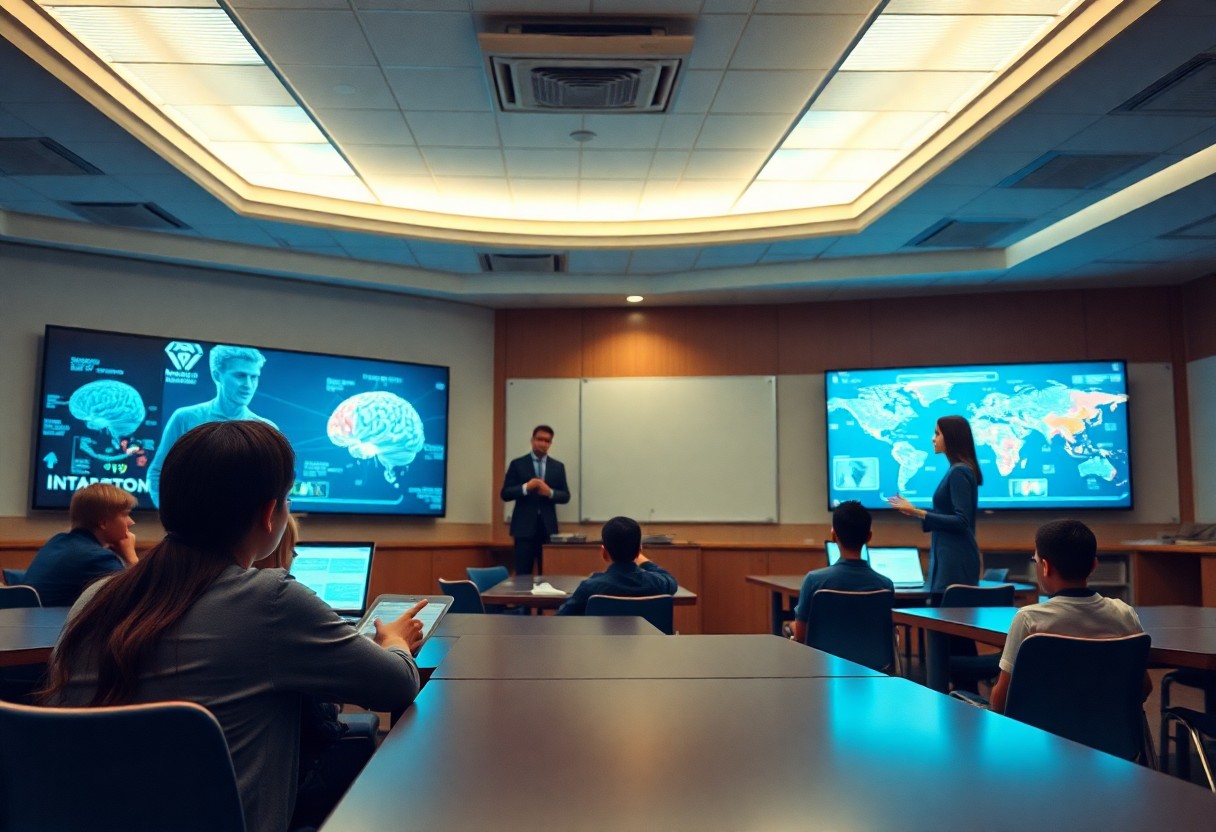Brain mapping serves as a powerful tool in understanding how you learn, enabling the design of advanced classroom solutions that enhance educational experiences. By analyzing cognitive processes, you can tailor teaching strategies to match neural patterns, improving information retention and engagement. This approach not only fosters personalized learning but also creates an environment where you can thrive academically. Discover how integrating brain mapping into your classroom can revolutionize the way you and your peers absorb knowledge.
Understanding Brain Mapping
For educators and learners alike, brain mapping offers exciting insights into how we process information, absorb knowledge, and engage in critical thinking. By analyzing brain activity and identifying patterns through various methodologies, you gain a clearer understanding of learning preferences, potential cognitive challenges, and optimal teaching strategies that can be tailored to meet individual needs. This approach provides a personalized educational experience, allowing you to maximize learning efficiency and outcomes in the classroom. As educational paradigms shift to incorporate neuroscience, brain mapping becomes an invaluable tool in fostering effective learning environments.
The Science Behind Brain Mapping
Brain mapping explores the intricate workings of the human brain by utilizing advanced technology to visualize brain structures and functions. Through this scientific examination, you uncover how different regions of the brain are activated during various cognitive tasks, such as problem-solving, reading, or memorizing. This knowledge not only enhances your understanding of the brain’s role in learning but also informs the development of teaching methods that align with how your brain naturally operates.
Techniques Used in Brain Mapping
Mapping the brain involves various sophisticated techniques, including functional magnetic resonance imaging (fMRI), electroencephalography (EEG), and positron emission tomography (PET). Each of these methods allows researchers to observe brain activity in real-time and understand how different areas react to external stimuli and internal thought processes. Through these techniques, you can identify which instructional practices stimulate and engage your mind most effectively, paving the way for more robust learning experiences.
To further enhance your understanding of brain mapping, it is beneficial to explore how these techniques can be directly applied in educational settings. For instance, utilizing fMRI can give insight into the most effective ways to present information, while EEG can track real-time brain electrical activity to assess student engagement during lectures. By integrating findings from brain mapping studies into your instructional practices, you can create a dynamic learning environment that evolves with the needs of your students, ultimately leading to improved educational outcomes.
The Role of Neuroplasticity in Learning
Some studies suggest that neuroplasticity is a fundamental aspect of how you learn and adapt to new information. This capacity of the brain to reorganize itself by forming new neural connections emphasizes that learning is not a fixed state but rather a dynamic and ongoing process. As you engage with new material, your brain’s pathways are reshaped, enhancing your ability to acquire knowledge and skills over time. The phenomenon of neuroplasticity indicates that regardless of age, you have the potential to improve your cognitive abilities and adapt to challenges in the learning environment.
How the Brain Adapts to New Information
Above all, the brain’s ability to adapt to new information hinges on its structure and functions that are designed for flexibility. When you learn something new, synaptic connections between neurons are strengthened, creating a more efficient communication network. This enhancement enables you to recall information more easily and apply it in various contexts. Thus, the process of learning involves not only absorbing knowledge but also physical changes in your brain that facilitate this absorption.
Implications for Educational Practices
Information about neuroplasticity carries significant implications for educational practices, urging educators to consider techniques that foster a growth mindset among learners. Customizing teaching methods to engage different areas of the brain can optimize the learning experience, making it more effective. This flexibility allows you to exploit your unique learning preferences, ultimately leading to better outcomes and a deeper understanding of the material.
But implementing these insights into educational practices requires a shift in the traditional teaching models. You may need to embrace diverse methods, such as collaborative learning, hands-on activities, and technology integration, to stimulate different cognitive functions. By prioritizing experiences that promote neuroplasticity in your learning environment, you can not only enhance your own learning capabilities but also support the development of others in your educational setting.
Advanced Classroom Solutions
Clearly, the integration of brain mapping for learning has paved the way for advanced classroom solutions that cater to diverse student needs. You can optimize the educational landscape by leveraging data-driven insights that guide instructional methods and learning environments. These solutions not only enhance cognitive engagement but also ensure students are learning in ways that work best for them.
- Adaptive Learning Tools
- Real-time Feedback Systems
- Data Analytics for Performance Tracking
- Augmented Reality and Virtual Simulations
- Collaborative Learning Platforms
| Features of Advanced Classroom Solutions | Benefits for Students |
|---|---|
| Personalized Learning Paths | Increased engagement and understanding |
| Interactive Learning Environments | Enhanced retention of information |
| Data-Driven Instruction | Targeted support for diverse learners |
Personalized Learning Experiences
About personalized learning experiences, it is necessary to recognize that each student has unique cognitive processes and learning preferences. By implementing brain mapping techniques, you can gain insights into how students think, feel, and learn. These insights allow for tailored instruction that accommodates individual strengths and weaknesses, leading to improved academic outcomes.
Furthermore, personalized learning experiences foster a sense of ownership among students regarding their educational journey. You can create a supportive environment where students feel empowered to explore content that resonates with them. This approach not only boosts motivation but also encourages lifelong learning habits, enhancing their overall educational experience.
Integrating Technology with Brain Insights
Between the advancement of educational technology and your understanding of brain-based learning strategies, there lies an opportunity to revolutionize learning experiences. By integrating cutting-edge technology with insights derived from brain mapping, you can create dynamic and effective instructional methods that respond to real-time student needs and preferences.
Solutions driven by data are transforming traditional classrooms into adaptive learning environments. By using wearable brain sensors and AI-driven analytics, you can identify when students are engaged or struggling, allowing you to tweak your strategies on the fly. This integration ensures that you can provide a responsive and nurturing learning atmosphere, ultimately enhancing student achievement and satisfaction.
Case Studies: Successful Implementation
Now, let’s explore into some compelling case studies that showcase the successful implementation of brain mapping for learning within various educational settings. These examples not only highlight innovative approaches but also provide data that illustrate significant improvements in student outcomes.
- Highland Heights Academy: Implemented brain mapping technology in their classroom settings, resulting in a 30% increase in overall student engagement within the first semester.
- Lakeside High School: Utilized brain mapping to tailor individualized learning plans, observing a 25% improvement in standardized test scores over one academic year.
- Maple Grove Elementary: Integrated brain mapping as part of their learning curriculum, with a notable 40% reduction in behavioral issues reported among students within the first three months.
- Greenwood International School: After adopting brain mapping techniques, they recorded a significant 50% increase in reading comprehension scores, enhancing overall literacy rates across the school.
- Sunrise Academy: Employed brain mapping tools to optimize teaching methodologies, leading to a 35% enhancement in collaborative learning outcomes as measured by peer reviews and assessments.
Schools Utilizing Brain Mapping
About the growing number of schools adopting brain mapping techniques, many educational institutions are now exploring how this innovative approach can facilitate advanced teaching solutions. Schools are recognizing the potential of brain mapping to create personalized learning experiences that cater to the unique needs of each student. By fostering an environment that embraces this technology, you can significantly enhance engagement and retention rates, which are vital for effective learning.
Measurable Outcomes in Student Performance
Performance metrics have shown that implementing brain mapping in classrooms can lead to substantial improvements in student outcomes. Various studies indicate that students who engaged with brain-mapping-enhanced curricula consistently displayed elevated performance levels compared to their peers. This transformation is attributed to a deeper understanding of how their brains work, which helps them discover and capitalize on their individual learning styles.
At various institutions, educators have noted that students not only improved academically but also displayed increased motivation and self-efficacy. For instance, schools that employed brain mapping reported much higher levels of student satisfaction and engagement in their curriculum, fostering a healthier school environment focused on continual learning and adaptation. By leveraging these techniques, you can set your educational institution apart, ensuring that your students are better prepared for the challenges of tomorrow.

Challenges and Concerns
To successfully implement brain mapping for learning, it is necessary to address several challenges and concerns that may arise. First, the accuracy and reliability of brain mapping data can vary, leading to potential misinterpretations of students’ cognitive capacities and learning preferences. These discrepancies may impact the tailored instructional strategies that depend on this data, causing educators to make decisions based on incomplete or flawed information. Additionally, the integration of advanced technologies into traditional classroom settings may require training for teachers and staff, which could encounter resistance and require significant adjustments in teaching methodologies.
Ethical Considerations in Brain Mapping
Below the surface of innovative brain mapping technologies lie numerous ethical considerations that you need to be aware of. The collection of neural data can raise questions about privacy, consent, and the potential for misuse of information. It is vital to ensure that students and parents are informed about what data is being collected, how it will be used, and who will have access to it. Furthermore, the possibility of interpreting brain data for tracking purposes raises concerns about labeling students and potentially leading to harmful biases in educational settings.
Limitations of Current Technologies
An integral part of any discussion surrounding brain mapping is the acknowledgment of the limitations that current technologies face. Despite advancements, the technology used for brain mapping is still largely in its developmental phase, often characterized by high costs and accessibility challenges for many educational institutions. Additionally, the complexity of the human brain means that current technologies may not yet provide comprehensive insights into the individual learning processes of each student. This limitation can mean that brain mapping may serve as just one of many tools in enhancing educational experiences rather than a standalone solution.
Ethical implications also intertwine with these limitations, as the effectiveness of brain mapping in providing actionable data can be hindered by a lack of standards in interpreting results. Without clear guidelines on how to utilize brain mapping insights responsibly, there may be a risk of misrepresentation or over-reliance on neural data in educational decisions. As you navigate these challenges, maintaining an awareness of ethical guidelines and technological limitations will be necessary in fostering an environment where brain mapping can genuinely enhance learning experiences for students.
Future Trends in Educational Neuroscience
Once again, the field of educational neuroscience is on the cusp of transformative discoveries that hold great promise for enhancing learning experiences. As our understanding of the brain’s working mechanisms evolves, researchers continue to explore various applications that can revolutionize educational methods. Integrating these findings into classroom environments allows you to not only tailor learning experiences to individual needs but also address diverse learning styles that can often be overlooked in traditional settings. This shift towards a more personalized approach in education ultimately aims to create a more engaging and effective learning atmosphere for you and your peers.
Emerging Technologies and Techniques
One of the most exciting aspects of future trends in educational neuroscience is the rise of emerging technologies and techniques designed to optimize learning. Brain imaging tools, such as functional MRI and EEG, are becoming increasingly accessible in educational settings, providing insights into cognitive processes as they occur. With this real-time data, educators like you can adapt instructional strategies on-the-fly, tailoring content to match students’ neural responses. Coupled with advancements in artificial intelligence, these technologies pave the way for sophisticated learning platforms that can provide personalized resources based on your unique brain activity.
Predictions for Classroom Integration
Techniques for integrating neuroscience into the classroom are also evolving. Experts predict that, in the near future, classrooms will increasingly embrace evidence-based practices derived from neuroscientific research. This may manifest as curricula designed around cognitive load theory, facilitating better retention of information, or employing mindfulness techniques that promote emotional well-being and active engagement. These proactive approaches will empower educators to refine their teaching methods, allowing you and your classmates to harness the full potential of your learning capacities.
Also, the anticipation surrounding neuroscience-driven classroom practices includes the development of smart devices tailored to monitor your physiological and cognitive states while you learn. Such innovations could enable real-time assessments, allowing for instant feedback and immediate adaptations in teaching strategies. This ensures you receive the support needed to enhance your learning experience continually, leading to a more interactive, engaging, and effective educational environment. As these developments unfold, you can expect your classroom experiences to become increasingly aligned with how your brain functions, setting the stage for a new era in learning.
Summing up
Following this exploration of brain mapping for learning, you can appreciate how these advanced techniques can significantly enhance your classroom solutions. By utilizing brain mapping, you gain deeper insights into students’ cognitive processes, enabling tailored instructional methods that resonate with their unique learning styles. This approach not only boosts engagement but also facilitates the retention of knowledge by aligning teaching strategies with the way students naturally process information.
Moreover, integrating brain mapping into your educational framework empowers you to identify areas where students may struggle, allowing for timely interventions and support. Implementing these advanced classroom solutions fosters a more inclusive and effective learning environment, ultimately driving academic success. By embracing brain mapping, you not only enhance your teaching effectiveness but also contribute to a more adaptive educational landscape where every learner can thrive.
Q: How does brain mapping for learning help in understanding student behavior in the classroom?
A: Brain mapping for learning provides insights into how different students process information, their cognitive strengths, and weaknesses, as well as their emotional responses to various learning scenarios. Through techniques such as functional MRI or EEG, educators can identify patterns in brain activity that correlate with engagement, motivation, or stress. This information allows teachers to tailor their instructional strategies, foster a supportive learning environment, and address individual needs more effectively, ultimately improving student outcomes.
Q: In what ways can brain mapping technology aid in developing personalized learning strategies?
A: By utilizing brain mapping technology, educators can better understand the distinct learning preferences and neurophysiological profiles of their students. This insight enables them to create customized learning experiences that align with each student’s unique brain wiring. For example, if brain mapping indicates a student is particularly adept at visual learning, the teacher can incorporate more visual aids and interactive materials into that student’s curriculum. The goal is to enhance engagement and retention, ultimately leading to a more effective educational experience tailored to each learner’s needs.
Q: Can brain mapping contribute to the effectiveness of collaborative learning environments?
A: Yes, brain mapping can play a significant role in enhancing collaborative learning environments. By analyzing how students’ brains interact during group activities, educators can gain insights into the dynamics of teamwork and communication. This understanding can inform the design of group tasks that optimize collaboration and peer learning. For instance, recognizing that certain students thrive in discussion-based settings can help educators create opportunities for those students to lead group conversations or debates, leveraging their strengths to enhance the overall effectiveness of the collaborative experience.




0 Comments